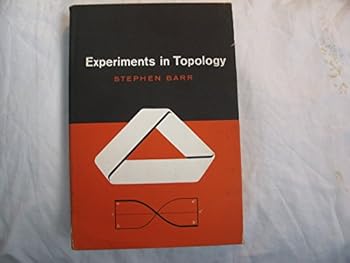Experiments in Topology
Select Format
Select Condition 
Book Overview
Classic, lively explanation of one of the byways of mathematics. Klein bottles, Moebius strips, projective planes, map coloring, problem of the Koenigsberg bridges, much more, described with clarity and wit.
Format:Hardcover
Language:English
ISBN:0690278624
ISBN13:9780690278620
Release Date:January 1964
Publisher:HarperCollins Children's Books
Length:210 Pages
Weight:0.96 lbs.
Age Range:12 years and up
Grade Range:Grade 7 and higher
Customer Reviews
1 rating
Great book for high school teachers and the popular audience
Published by Thriftbooks.com User , 22 years ago
Written for the beginner in topology but still presupposing a certain amount of mathematical maturity, this book is great fun and should be useful to high school teachers, and those who might be giving public talks on mathematics to audiences who are very interested in mathematics, but who don't have a substantial background in the subject. It is always helpful in those scenarios to have concrete examples that will illustrate some of the more difficult constructions in topology. In chapter 1, the author attempts to give an intuitive definition of topology. The author uses various pictures and handwaving arguments to explain various notions in topology, such as homeomorphism ("coffee cup = donut"), simply connected (object with no holes), homology (two circles can intersect at one point only), Jordan curves, and Euler's theorem. In chapter 2, the author uses paper models to illustrate the topology of surfaces, both orientable and nonorientable. The author gives instructions on how to make a paper model of a Klein bottle, but cautions the reader that such a model is not an exact representation of the mathematical object rigorously defined in topology, since the surface passes through itself in the paper construction. Chapter 3 is a set of instructions on how to make a "shortest" Moebius strip. The procedures for doing this are interesting and fun, for the author constructs a Moebius strip whose length is less than its width, by a factor of 1 over the square root of 3. He devotes an appendix for an improvement due to Martin Gardner of Scientific American fame. In chapter 4 the author constructs what he calls a "conical Moebius strip". The author asks the reader to consider an annulus with a radial slit, with which of course one can construct a Moebius strip by twisting the ends and joining them. But he asks how large the hole must be in relation to the outside diameter. The answer to this is that one does not need any hole at all in order to carry out the construction. In fact, an angular segment can be cut out instead of the radial cut, and this leads him to construct the conical Moebius strip. The author returns to the Klein bottle in chapter 5, and shows first what happens if the usual construction of the Klein bottle is cut down the center symmetrically: two Moebius strips are obtained. But to construct this model is difficult, so he gives alternate constructions for making the Klein bottle. He then shows what happens to the various models when the pieces are cut. But how do you make a projective plane using scissors and paper? Intuitively one can imagine this would be very difficult, but the author shows ways to do it in chapter 6. His strategy for making these models is to teach the concept of symmetry in topology, and he pulls this off very well. The famous 4-color problem for maps, i.e. that one needs only 4 colors for a map, is considered in chapter 7. At the time of publication, the 4-color problem was still open, so the author attem






